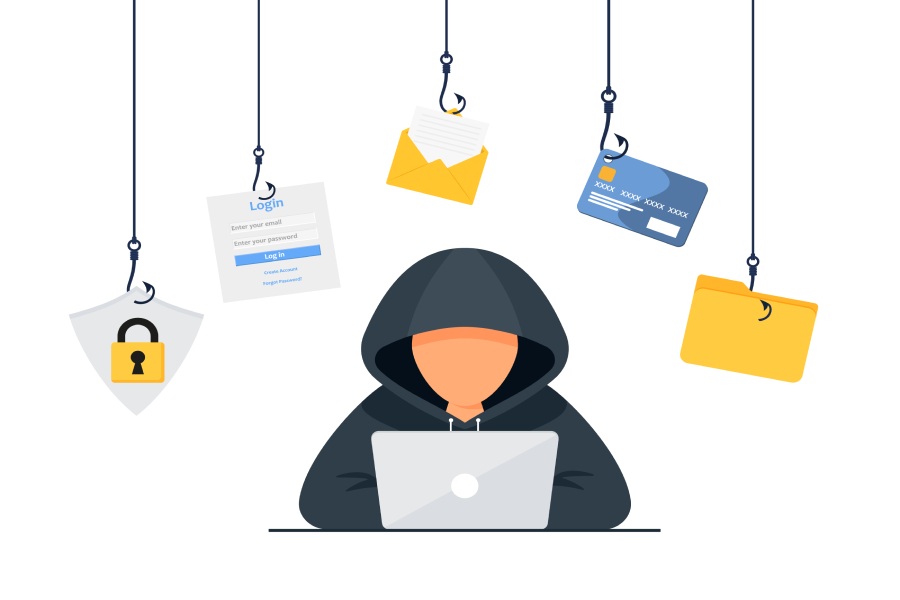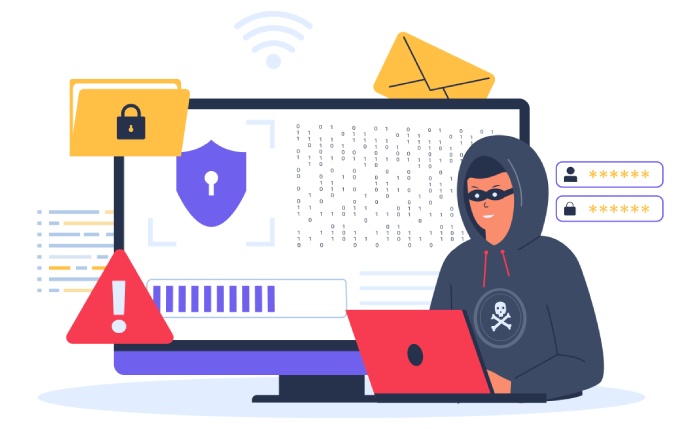Today’s cyber adversaries don’t merely rely on computer viruses and worms to target an individual digitally but make use of sophisticated social engineering (phishing) techniques to rob the end-users of their PII (Personally Identifiable Information) and other confidential information. And businesses are no different, especially online businesses such as e-commerce; they are more lucrative targets for them. Their modus operandi includes masquerading themselves as authorized entities, sending out fraudulent emails, text messages, or even making phone calls to lure customers and clients and mislead them into divulging sensitive information. Here’s how these threat actors target e-commerce businesses.
Cyber Threats That Target E-commerce Businesses
Before delving into how you can protect your information assets, you must first understand how online adversaries target your business and customers. Some of the most common cyber threats faced by e-commerce businesses are discussed below.
Card Cracking
Card cracking occurs when cybercriminals acquire credit card details. Despite having these details, cybercriminals do not have information regarding the limit of credit cards. To verify this information, they initially make small purchases. Since these purchases are small, they often go unnoticed by the impacted customer. When they notice that they are victims of cyber theft, larger orders have already been placed against their credit cards.
Chargeback Fraud
E-commerce businesses are often a victim of chargeback fraud. These frauds are usually carried out by attackers who make purchases from the businesses and then claim that they never received the product they ordered. The enterprises then have to reimburse the “loss” of this product.
Refund Fraud
This kind of fraud occurs when a purchase is made with stolen credit card information. The attackers purchase with this information and then contact the e-commerce business they have to cancel the order. They then ask for reimbursement against the purchase to be sent to them through another medium instead of refunding the credit card.
Triangulation Fraud
Triangulation fraud involves an e-commerce store, a shopper, and a cybercriminal. The cybercriminal sets up an e-commerce store on a storefront platform (such as Amazon) and claims to sell high-end products at competitive prices. The customers looking for a good deal make a purchase from this store. Once they make a purchase, the cybercriminal will use stolen credit card information to make purchases according to the orders they have received from their customers. Although the customers of these stores receive their orders, the credit card owner suffers a loss. This loss might have to be refunded by the storefront platform.
How Can Phishing Attacks Threaten Your Ecommerce Business?
Phishing attacks are not aimed at stealing just your money. They target something way more valuable, your data. An e-commerce business can have the PII (Personally Identifiable Information) and other critical information such as payment details of thousands of customers, which is nothing less than a goldmine for threat actors. Phishing can have a variety of adverse effects on online businesses when subjected to data breaches, for example:
- Monetary Losses: Financial loss is one of the worst impacts of a phishing attack. A customer or employee clicking or replying to a phishing email could end up jeopardizing their bank credentials, passwords, etc., leading to financial losses. The impact can be ascertained by the global average cost of a data breach, which stands at a staggering $3.86 million.
- Loss of Sensitive Data: Phishing attacks may lead to the loss of sensitive data, such as login and passwords details, bank accounts details, stolen credit card information related to clients and customers or even the organization itself.
- Loss of reputation: Keeping its brand value intact is of utmost importance for any e-commerce business. Phishing attacks, once occurred, may drive away existing and potential customers in fear of fraudulent activities and data breaches.
- Disruption of Normal Conduct of Business: Cybercriminals may target your bank accounts, causing you to suspend the account actions and transactions till the issue of cyber theft is resolved.
How to Protect Your Ecommerce Business from Phishing?
There is an array of anti-phishing solutions that you can implement in your e-commerce business. Here are a few of the best phishing protection methods for your enterprise:
Shift from HTTP to HTTPS Protocols
HTTP protocols are not only backdated but also open to phishing, malware, and other attacks. Many browsers often mark HTTP protocols as unsecured and refuse to let the user gain access to the website. By shifting to HTTPS protocols, you can keep sensitive data and user credentials protected from cybercriminals to an extent (do note that this is not one-hundred percent foolproof).
Train Your Employees and Inform Your Customers
Employees establish the first line of defense against social engineering threats such as phishing.
- You can train your employees to avoid clicking on suspicious links or downloading attachments sent through malicious-looking emails.
- You may remind your customers that the addresses and logos used by cybercriminals are often quite similar to the original ones except for an alphabet or two that might be altered.
- You can inform your customers to not reveal sensitive data over SMS and voice calls. You can explain that your enterprise is unlikely to ask for any such data.
Maintaining basic cyber hygiene practices and vigilance can go a long way in protecting your e-commerce business from phishing attacks.
Keeping Regular Backups of Data
Malware and ransomware attacks often target your data: once you lose access to your computer, you will no longer acquire the data you stored there. To prevent such a mishap, you can deploy an automatic backup software or service that can keep your data protected on an external device. Henceforth, even if you lose access to your stored data on the computer, it will not affect your e-commerce business tremendously.
Anti-malware and Anti-ransomware Solutions
You can install software and solutions that can prevent malware and ransomware attacks. Software solutions from reliable vendors can assist in keeping such attacks at bay. Certain anti-malware software can help you decrypt and remove the malware from your system in the worst-case scenario, while others can help you prevent a potential cyber attack.
Implement New and Strong Passwords
According to a recent survey, 21% of ransomware attacks take place due to vulnerable passwords resulting in ease of access. Hence, implementing strong passwords and changing them now and then is vital for business owners and customers alike.
Implement 2FA & MFA
2FA (2-factor Authentication) and MFA (Multi-factor Authentication) use two or more factors to authenticate the user trying to access an application. They utilize messages, emails, or thumbprints to verify whether the user accessing an application is genuine or not. This provides an additional layer of safety to consumers, where transactions are made only after completing all the authentication steps.
Final Words
Global losses to cyberattacks amounted to nearly $1 billion in 2020, and this trend is likely to continue in the coming years. Today’s threat actors are smart, and business owners need to take relevant anti-phishing and other such cybersecurity measures to remain a step ahead of them at all times. It is all the more important for e-commerce stores as they not only have to protect their information assets but also protect the information of their customers to keep their privacy intact.



